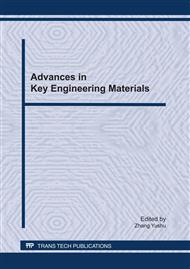p.65
p.70
p.75
p.80
p.84
p.89
p.93
p.97
p.103
The Influence on the Properties of Microporous Mullite of Adding Different Burning-Out Materials
Abstract:
Mullite has low thermal conductivity, advanced volume stability at high temperature, and is suit to prepare lightweight refractories. The micropored mullite aggregates has been produced by using industrial alumina and natural silica as starting materials, adding some burning-out materials, then fired at 1350°C for 6h. The influences on the bulk density, pore size distribution and microstructure of microporous mullite of adding these burning-out materials, such as carbon black, coke, and anthracite have been investigated. The conclusions are that the influences on the bulk density and microstructure of micropored mullite aggregates are significant. These three burning-out materials have a similar effect for the pore size distribution. The microporous mullite aggregates has the smallest bulk density and more uniform microstructure by using anthracite as the burning-out material.
Info:
Periodical:
Pages:
84-88
Citation:
Online since:
February 2011
Authors:
Keywords:
Price:
Сopyright:
© 2011 Trans Tech Publications Ltd. All Rights Reserved
Share:
Citation:


